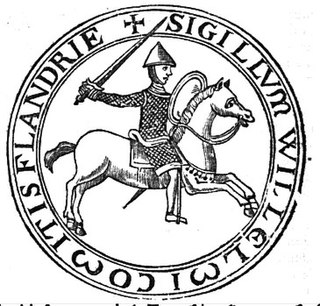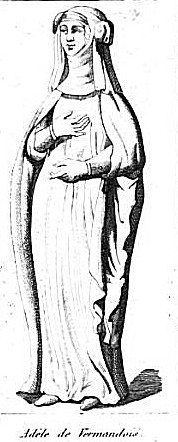
William Clito was a member of the House of Normandy who ruled the County of Flanders from 1127 until his death and unsuccessfully claimed the Duchy of Normandy. As the son of Robert Curthose, the eldest son of William the Conqueror, William Clito was seen as a candidate to succeed his uncle King Henry I of England. Henry viewed him as a rival, however, and William allied himself with King Louis VI of France. Louis installed him as the new count of Flanders upon the assassination of Charles the Good, but the Flemings soon revolted and William died in the struggle against another claimant to Flanders, Thierry of Alsace.

Arnulf I, called "the Great", was the first Count of Flanders.

Charles the Good was Count of Flanders from 1119 to 1127. His murder and its aftermath were chronicled by Galbert of Bruges. He was beatified by Pope Leo XIII in 1882 through cultusconfirmation.
Hugh II was the count of St. Pol in Artois, after having succeeded his brother Guy I who died without issue. He was the son of Hugh I. He participated in the First Crusade (1096–99) with his son Enguerrand, where they both won fame as military leaders. Being vassals of Eustace III of Boulogne, they probably travelled east in his company, among the retinue of Godfrey of Bouillon.
William of Ypres was a Flemish nobleman and one of the first mercenary captains of the Middle Ages. Following two unsuccessful bids for the County of Flanders, William became King Stephen of England's chief lieutenant during the civil war of 1139–54 known as the Anarchy. He held Kent, though not the title of earl, until the early years of King Henry II's reign, when he returned to Flanders.
Adela of Flanders, was Queen consort of Denmark by marriage to King Canute IV and duchess of Apulia by marriage to Duke Roger Borsa, and then regent of Apulia from 1111 to 1115 as mother and guardian of Duke William II.

Adelaide of Vermandois was suo jure Countess of Vermandois and Valois from 1080 to 1102. She was the last landed ruler of the Carolingian dynasty.
St. Andrew's Abbey, Bruges was a Benedictine abbey in Sint-Andries, Bruges, Belgium, which was destroyed in the French Revolution. Its modern successor St. Andrew's Abbey, Zevenkerken, founded in 1899–1900, is a Benedictine abbey of the Congregation of the Annunciation.
Clementia of Burgundy was countess of Flanders by marriage to Robert II of Flanders. She acted as regent of Flanders from 1096 until 1100, while her spouse was on crusade, and in the name of their son Baldwin VII from 1111 until 1119.
Gertrude of Flanders, was a Countess of Louvain and Landgravine of Brabant by marriage to Henry III, Count of Leuven, and a Duchess of Lorraine by marriage to Theodoric II, Duke of Lorraine. At the time the duchy was the upper Lorraine, since 959 separated from the duchy of Lower Lorraine.
The following is a timeline of the history of the municipality of Bruges, Belgium.
Renaud II of Clermont was son of Hugh I, Count of Clermont-en-Beauvaisis and Marguerite de Roucy. Renaud became Count of Clermont-en-Beauvaisis upon his father's death in 1101.
Margaret of Clermont was a countess consort of Flanders twice by marriage to Charles I, Count of Flanders and Thierry, Count of Flanders. She was ruling suo jure countess regnant of Amiens 1118–1132.
Robert II of Flanders' army was formed shortly after that of his kinsman Godfrey of Bouillon, arriving in Constantinople considerably later. His wife Clementia of Burgundy was regent of Flanders in his absence. The known members of the army, mostly Flemish, included the ones listed below, as reported in histories of the First Crusade. Unless otherwise noted, references are to the on-line database of Riley-Smith, et al., and the hyperlinks therein provide details including original sources. The names below are also referenced in the Riley-Smith tome, Appendix I: Preliminary List of Crusaders. Those references are not shown unless they appear elsewhere in the text of the book. Articles that are hyperlinked to a more detailed article in this encyclopædia rely on the latter for references.

Hedwig of Formbach was the daughter of Frederick, count of Formbach and of Gertrude of Haldensleben, and heiress to Süpplingenburg Castle. She was the mother of Emperor Lothair II.

Het Steen was a medieval building on the Burg Square in Bruges, Belgium. Between the late 11th and late 13th centuries, it served as the residence of the Counts of Flanders.
Hugh III was count of Saint-Pol from 1130 until his death in 1141. He was responsible for massacres and therefore excommunicated.
In fabliaux, bacon is one of the most commonly consumed foodstuffs, alongside capons and geese, cakes, bread, and wine.
The Battle of Axspoele took place on 21 June 1128 on the landed estate of the lords of Axpoele in the County of Flanders between William Clito and Thierry of Alsace. The two men were rivals for the title of Count of Flanders. William had been appointed to the title by Louis VI of France following the 1127 murder of Charles the Good but Thierry, cousin of Charles, had the support of Henry I of England. In 1128, Thierry secured the support of a number of Flemish cities, although most of the nobility supported William.
Alan V. Murray is a Scottish historian and philologist specializing in the history of the Crusades, medieval warfare and tournaments, and Middle High German language and literature. He is Professor of Medieval European History at the University of Leeds and a former Director of the International Medieval Bibliography (IMB).






